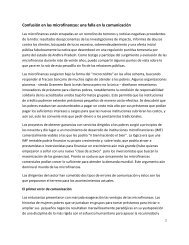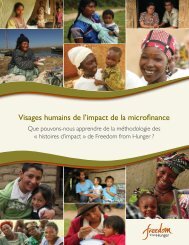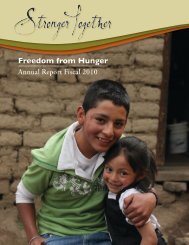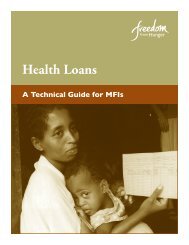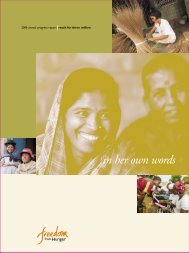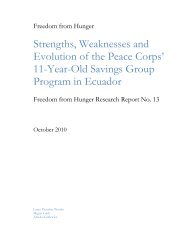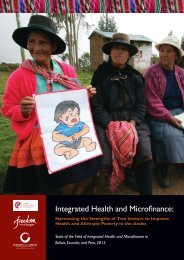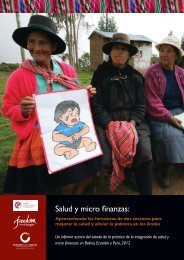history of meals for millions, soy, and freedom from ... - SoyInfo Center
history of meals for millions, soy, and freedom from ... - SoyInfo Center
history of meals for millions, soy, and freedom from ... - SoyInfo Center
You also want an ePaper? Increase the reach of your titles
YUMPU automatically turns print PDFs into web optimized ePapers that Google loves.
Springs Conference held by <strong>for</strong>ty-four nations at the<br />
Homestead Hotel, Hot Springs, Virginia, <strong>from</strong> May 18 to<br />
June 3, 1943. President Franklin D. Roosevelt issued an<br />
invitation to this conference at the peak <strong>of</strong> World War II, on<br />
30 March 1943, to countries associated with the United<br />
States in the war, to discuss world problems <strong>of</strong> agriculture,<br />
nutrition an food. “This first World Food Congress<br />
established an interim commission with an <strong>of</strong>fice in<br />
Washington, D.C., which functioned until” FAO was<br />
<strong>for</strong>mally established as an agency <strong>of</strong> the United Nations on<br />
16 Oct. 1945 in Quebec, Canada, to assume the work <strong>of</strong> the<br />
International Agriculture Institute <strong>and</strong> is presently governed<br />
by the U.N. Conference <strong>of</strong> Member Nations. FAO’s<br />
headquarters was transferred <strong>from</strong> Washington to Rome,<br />
Italy, in early 1951 (p. 101).<br />
“In July 1960, FAO, with the approval <strong>and</strong> cooperation<br />
<strong>of</strong> the United Nations system, launched the five-year,<br />
worldwide Freedom <strong>from</strong> Hunger Campaign.” The message<br />
<strong>of</strong> this campaign “to the more affluent nations has<br />
concentrated on arousing public awareness <strong>of</strong> the danger<br />
which global hunger <strong>and</strong> malnutrition pose to the peace <strong>and</strong><br />
progress <strong>of</strong> mankind. It has also sought to encourage<br />
international cooperation in facing up to the solution <strong>of</strong><br />
these problems.”<br />
“Every nation has been urged to establish a Citizens’<br />
Freedom <strong>from</strong> Hunger Foundation to raise funds <strong>for</strong> the<br />
campaign. In this way private individuals, women’s clubs,<br />
religious groups, civic organizations, <strong>and</strong> commercial firms<br />
can participate through contributions <strong>of</strong> money or materials.<br />
“The American Freedom <strong>from</strong> Hunger Foundation<br />
Campaign was named by President Kennedy on November<br />
22, 1961, the day be<strong>for</strong>e Thanksgiving.” A ceremony in the<br />
White House launched the U.S. phase <strong>of</strong> the campaign.<br />
Alvin Shapiro <strong>of</strong> Washington, DC, as the first head <strong>of</strong> the<br />
American Foundation (p. 103-04). A photo (facing p. 15)<br />
shows the people present at the launching <strong>of</strong> the FFH<br />
Campaign in the Fish Room <strong>of</strong> the White House (left to<br />
right): Marian Anderson, Senator George McGovern,<br />
President John F. Kennedy, German Chancellor Konrad<br />
Adenauer, <strong>and</strong> Mrs. Woodrow Wilson.<br />
“A highlight <strong>of</strong> the campaign was the World Food<br />
Congress in Washington, D.C., June 14-18, 1963, timed to<br />
commemorate the twentieth anniversary <strong>of</strong> the Hot Springs<br />
World Food Conference” [in Virginia]. President Kennedy<br />
opened the conference with a memorable speech (p. 106).<br />
The United States pledged $40 million in commodities, as<br />
part <strong>of</strong> a program to reduce U.S. food surpluses <strong>and</strong> also<br />
feed the hungry (p. 108).<br />
Note: In March 1979 The American Freedom <strong>from</strong><br />
Hunger Foundation merged with the Meals <strong>for</strong> Millions<br />
Foundation to become the “Meals <strong>for</strong> Millions / Freedom<br />
<strong>from</strong> Hunger Foundation.”<br />
The World Food Program was first established at the<br />
1960 Food <strong>and</strong> Agricultural Organization (FAO)<br />
MEALS FOR MILLIONS, SOY, AND FREEDOM FROM HUNGER 79<br />
© Copyright Soyinfo <strong>Center</strong> 2011<br />
Conference, when George McGovern, director <strong>of</strong> the US<br />
Food <strong>for</strong> Peace Program, proposed establishing a<br />
multilateral food aid program. WFP was <strong>for</strong>mally<br />
established in 1963 by the FAO <strong>and</strong> the United Nations<br />
General Assembly on a three-year experimental basis. In<br />
1965, the program was extended to a continuing basis.<br />
Chapter 8, “Victory in the war against want, begins: On<br />
23 Sept. 1959 Soviet premier Nikita Khruschev, at the start<br />
<strong>of</strong> his visit to the United States, visited the farm <strong>of</strong> Roswell<br />
Garst near the city <strong>of</strong> Coon Rapids, Iowa. He wanted to<br />
learn more about modern agriculture. In the Soviet Union<br />
nearly 50% <strong>of</strong> the entire labor <strong>for</strong>ce was involved in<br />
producing food, compared with only 8% in the United<br />
States. Yet the remaining 92% <strong>of</strong> Americans are better fed<br />
than is the Russian populace, <strong>and</strong> the USA has surplus food<br />
which it uses to feed the hungry overseas (p. 113-14).<br />
“The great changes in American agriculture came at an<br />
accelerating pace after 1915 with the sharply increased<br />
dem<strong>and</strong>s <strong>for</strong> food <strong>of</strong> World War I serving as a catalyst. In<br />
the half century since then the American farm has been<br />
trans<strong>for</strong>med. Every phase <strong>of</strong> the farm operation is heavily<br />
assisted by machinery. Rural electrification not only lights<br />
the farmhouse but runs everything <strong>from</strong> water pump to<br />
milking machine, hybrid seed, chemical fertilizer,<br />
pesticides, livestock feed supplements, <strong>soy</strong>bean products,<br />
<strong>and</strong> a host <strong>of</strong> other developments, including the cooperative<br />
movement, have changed the face <strong>and</strong> <strong>for</strong>m <strong>of</strong> rural<br />
America.”<br />
In 1862, under Abraham Lincoln <strong>and</strong> during the Civil<br />
War, three historic acts “laid the institutional foundation <strong>of</strong><br />
American agriculture: The Homestead Act, the Morrill Act,<br />
<strong>and</strong> the creation <strong>of</strong> the Department <strong>of</strong> Agriculture (p. 115-<br />
16).<br />
In the last half <strong>of</strong> Chapter 8 McGovern suggests “a tenpoint<br />
battle plan against hunger led by the American people,<br />
which I am convinced will end in victory.” These are largely<br />
McGovern’s opinions about how the Food <strong>for</strong> Peace<br />
program could be improved <strong>and</strong> exp<strong>and</strong>ed. Four example,<br />
No. 4 is to “eliminate the political restrictions on our Food<br />
<strong>for</strong> Peace (FFP) program.” He advocates that surplus<br />
American food be sent to hungry people (especially<br />
children) living in Communist countries, such as the USSR,<br />
China, or Cuba.<br />
Appendix I gives 4 pages <strong>of</strong> statistics about the FFP<br />
program, including a graph showing the dollar value <strong>of</strong> FFP<br />
shipments to 5 different regions <strong>of</strong> the world <strong>from</strong> 1955 to<br />
1963. Shipments to Europe peaked in 1957 at $850 million<br />
<strong>and</strong> decreased sharply thereafter. Shipments to the Near<br />
East <strong>and</strong> South Asia peaked in 1961 at $700 million <strong>and</strong><br />
have decreased since then but were still the largest in 1963.<br />
Appendix II includes directories <strong>of</strong>: (1) The executive<br />
committee <strong>of</strong> the American Food <strong>for</strong> Peace Council. Many<br />
<strong>of</strong> the members <strong>of</strong> the Executive Committee are private<br />
citizens. Mr. Dwayne O. Andreas, an Executive Vice



